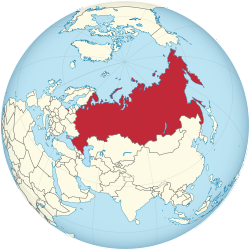Russia, the largest country in the world, has international land borders with fourteen sovereign states[1] as well as 2 narrow maritime boundaries with the United States and Japan. There are also two breakaway states bordering Russia, namely Abkhazia and South Ossetia. The country has an internationally recognized land border running 22,407 kilometres (13,923 mi) in total,[1] and has the second-longest land border of any country in the world, after China. The borders of the Russian Federation (formerly the Russian SFSR) were mostly drawn since 1956 (save for minor border changes, e.g., with China), and have remained the same after the dissolution of the Soviet Union. In 2014, Russia annexed Ukraine's Crimean peninsula in a move that remains internationally unrecognized.


As a transcontinental country in Eurasia, Russia shares borders in both Europe and Asia. Out of the 18 total land borders and maritime boundaries, 12 are in Europe and 5 are in Asia, while 1 border lies in the Bering Strait; between North America and Asia.
Overview edit
Russia shares borders with more countries than any other state in the world, owing to its large expanse.
Internationally recognized edit
| Country | Land | Sea | More information |
|---|---|---|---|
| Azerbaijan | 327.6 km (203.6 mi) | 22.4 km (13.9 mi) | Azerbaijan–Russia border |
| Belarus | 1,239.0 km (769.9 mi) | none | Belarus–Russia border |
| China | 4,209.3 km (2,615.5 mi) | none | China–Russia border |
| Estonia | 324.8 km (201.8 mi) | 142.0 km (88.2 mi) | Estonia–Russia border (border treaty not ratified) |
| Finland | 1,271.8 km (790.3 mi) | 54.0 km (33.6 mi) | Finland–Russia border |
| Georgia | 894 km (556 mi) | none | Georgia–Russia border |
| Japan (Russian and international claim) | none | 194.3 km (120.7 mi) | |
| Japan (Japanese claim) | none | ? | |
| Kazakhstan | 7,512.8 km (4,668.2 mi) | 85.8 km (53.3 mi) | Kazakhstan–Russia border |
| Latvia | 270.5 km (168.1 mi) | none | Latvia–Russia border |
| Lithuania | 266.0 km (165.3 mi) | 22.4 km (13.9 mi) | Lithuania–Russia border |
| Mongolia | 3,485.0 km (2,165.5 mi) | none | Mongolia–Russia border |
| North Korea South Korea |
17.3 km (10.7 mi) | 22.1 km (13.7 mi) | North Korea–Russia border Border claimed by the Republic of Korea |
| Norway | 195.8 km (121.7 mi) | 23.3 km (14.5 mi) | Norway–Russia border |
| Poland | 204.1 km (126.8 mi) | 32.2 km (20.0 mi) | Poland–Russia border |
| Ukraine | 1,974.04 km (1,226.61 mi) | 321 km (199 mi) | Russia–Ukraine border |
| United States | none | 49.0 km (30.4 mi) | USSR–USA Maritime Boundary Agreement |
Partially recognized edit
| Country | Land | Sea | Notes | More information |
|---|---|---|---|---|
| Abkhazia | 255.4 km (158.7 mi) | 22.4 km (13.9 mi) | The political status of Abkhazia is disputed. Having unilaterally declared independence from Georgia in 1992, Abkhazia is formally recognised as an independent state by 5 UN member states (two other states previously recognised it but then withdrew their recognition), while the remainder of the international community recognizes it as as de jure Georgian territory. Georgia continues to claim the area as its own territory, designating it as Russian-occupied territory. | Abkhazia–Russia border |
| South Ossetia | 70 km (43 mi) | none | South Ossetia's status is disputed. It considers itself to be an independent state, but this is recognised by only a few other countries. The Georgian government and most of the world's other states consider South Ossetia de jure a part of Georgia's territory. | South Ossetia–Russia border |
Border details edit
Below is a list of subjects with both neighbouring regions of Russia with them, and in the neighbouring regions of foreign countries.
Northwestern Federal District edit
- Russia
- Finland
- Russia
- Russia
- Russia
Volga Federal District edit
Southern Federal District edit
North Caucasian Federal District edit
Ural Federal District edit
Siberian Federal District edit
- Russia
- Kazakhstan
- China
- Mongolia
- Russia
- Mongolia
- Russia
- Mongolia
- Russia
- Kazakhstan
- Russia
- Mongolia
- China
- Russia
Far Eastern Federal District edit
Crimea edit
The status of the Crimea and of the city of Sevastopol is currently under dispute between Russia and Ukraine; Ukraine and the majority of the international community consider the Crimea to be an autonomous republic of Ukraine and Sevastopol to be one of Ukraine's cities with special status, while Russia, on the other hand, considers the Crimea to be a federal subject of Russia and Sevastopol to be one of Russia's three federal cities since the March 2014 annexation of Crimea by Russia.[2][3]
In 2022, Russia declared the annexation of Ukraine's Donetsk, Kherson, Luhansk and Zaporizhzhia regions, which remains internationally unrecognized.[4]
- Russia
- Ukraine
- Russia
See also edit
Notes edit
References edit
- ^ a b "Russia", The World Factbook, Central Intelligence Agency, 12 October 2022, retrieved 14 October 2022
- ^ Gutterman, Steve (18 March 2014). "Putin signs Crimea treaty, will not seize other Ukraine regions". Reuters.com. Archived from the original on 18 March 2014. Retrieved 26 March 2014.
- ^ "Ukraine crisis: Timeline". BBC News. 13 November 2014.
- ^ "Russia's Federation Council ratifies annexation of four Ukrainian regions". Reuters. 4 October 2022.
External links edit
- Федеральное агентство по обустройству государственной границы Российской Федерации (Росграница)/ The Federal Agency for the Development of the State Border Facilities of the Russian Federation (Rosgranitsa) – official site of the government agency responsible for Russia's international borders